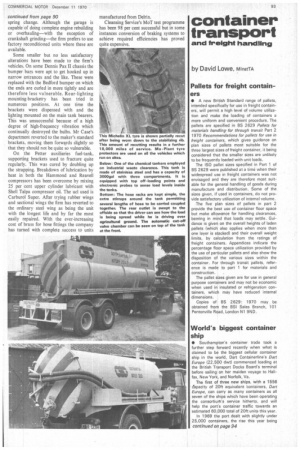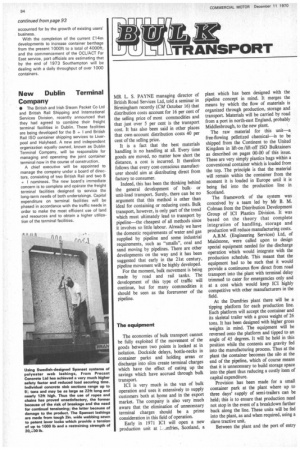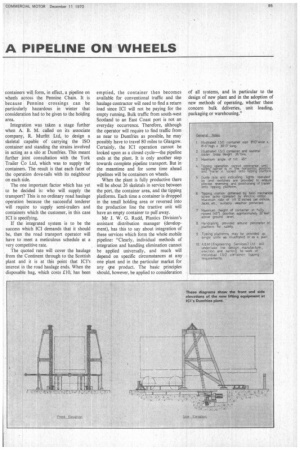container transport
Page 99

Page 100

Page 101

If you've noticed an error in this article please click here to report it so we can fix it.
and freight handling
by David Lowe, m I nstTA
Pallets for freight containers
• A new British Standard range of pallets, intended specifically for use in freight containers., will permit a high level of volume utilization and make the loading of containers a more uniform and convenient procedure. The pallets are specified in BS 2629 Pallets for materials handlingfor through transit Part 2 1970 Recommendations for pallets for use in freight containers, which gives guidance on plan sizes of pallets most suitable for the three largest sizes of freight container, it being considered that the smaller sizes are unlikely to be frequently loaded with unit loads.
The ISO pallet sizes specified in Part 1 of BS 2629 were published at a time when their widespread use in freight containers was not envisaged and they are therefore most suitable for the general handling of goods during manufacture and distribution. Some of the sizes given, if used in containers, do not provide satisfactory utilization of internal volume.
The five plan sizes of pallets in part 2 provide the best use of container floor space but make allowance for handling clearances, bearing in mind that loads may settle. Guidance is given on the overall heights of laden pallets (which also applies when more than one layer is stacked) and their overall weight limits, by calculation from the ratings of freight containers. Appendices indicate the percentage floor space utilization provided by the use of particular pallets and also show the disposition of the various sizes within the container. For through transit pallets, reference is made to part 1 for materials and construction. .
The pallet sizes given are for use in general purpose containers and may not be economic when used in insulated or refrigeration containers, which may have reduced internal dimensions.
Copies of BS 2629: 1970 may, be obtained from the BSI Sales Branch, 101 Pentonville Road, London Ni 9ND.
• Southampton's container trade took a further step forward recently when what is claimed to be the biggest cellular container ship in the world, Dart Containerline's Dart Europe (22,500 dwt) commenced loading at the British Transport Docks Board's terminal before sailing on her maiden voyage to Halifax, New York, and Norfolk, Va.
The first of three new ships, with a 1556 dapacity of 20ft equivalent 'containers, Dart Europe, can carry as many containers as all seven of the ships which have been operating the consortium's service hitherto, and will help the port's container traffic towards an estimated 60,000 total of 20ft units this year.
In 1969 the port dealt with slightly under 25,000 containers, the rise this year being continued on page 94 • The British and Irish Steam Packet Co Ltd and British Rail Shipping and International Services Division, recently announced that they had agreed to combine their freight terminal facilities in Dublin. These facilities are being developed for the B + I and British Rail ISO container shipping services to Liverpool and Holyhead. A new and independent organization equally owned, known as Dublin Terminal Company, will be responsible for managing and operating the joint container terminal now in the course of construction.
A chief executive will be appointed to manage the company under a board of directors, consisting of two British Rail and two B + I nominees. The new board's immediate concern is to complete and operate the freight terminal facilities designed to service the long-term needs of both undertakings. Capital expenditure on terminal facilities will be phased in accordance with the traffic needs in order to make the most efficient use of land and resources and to obtain a higher utilization of the terminal facilities.
MR L. S. PAYNE managing director of British Road Services Ltd, told a seminar in Birmingham recently (CM October 16) that distribution costs account for 16 per cent of the selling price of most commodities and that just over 5 per cent is the transport cost. It has also been said in other places that own-account distribution costs 40 per cent of the selling price.
It is a fact that the best materials handling is no handling at all. Every time goods are moved, no matter how short the distance, a cost is incurred. It therefore follows that every cost-conscious manufacturer should aim at distributing direct from factory to consumer.
Indeed, this has been the thinking behind the general development of bulkor unit-load transport. Surely, there can be no argument that this method is other than ideal for containing or reducing costs. Bulk transport, however, is only part of the trend which must ultimately lead to transport by pipeline—the cheapest of all methods since it involves so little labour. Already we have the domestic requirements of water and gas supplied by pipeline and some industrial requirements, such as "smalls", coal and sand moving by pipelines. There are other developments on the way and it has been suggested that early in the 21st century, pipeline movement will be highly developed.
For the moment, bulk movement is being made by road and rail tanks. The development of this type of traffic will continue, but for many commodities it should be seen as the forerunner of the pipeline.
The equipment
The economies of bulk transport cannot be fully exploited if the movement of the goods between two points is looked at in isolation. Dockside delays, bottle-necks in container parks and holding areas or discharge into silos create terminal charges which have the effect of eating up the savings which have accrued through bulk transport.
ICI is very much in the van of bulk operation and uses it extensively to supply customers both at home and in the export market. The company is also very much aware that the elimination of unnecessary terminal charges should be a prime consideration in this field of operation.
Early in 1971 ICI will open a new production unit at 1.....mfries, Scotland, a plant which has been designed with the pipeline concept in mind. It merges the means by which the flow of materials is organized through production, storage and transport. Materials will be carried by road from a port in north-east England, probably Middlesbrough, to the new plant.
The raw material for this unit—a free-flowing pelletized chemical—is to be shipped from the Continent to the United Kingdom in lift-on/lift-off ISO Bulktainers as described on pages 00-00 of this issue. These are very simply plastics bags within a conventional container which is loaded from the top. The principle is that the material will remain within the container from the moment it is loaded in Europe until it is being fed into the production line in Scotland.
The framework of the system was conceived by a team led by Mr B. M. Colman from the Distribution Development Group of ICI Plastics Division. It was based on the theory that complete integration of handling, storage and production will reduce manufacturing costs.
A.B.M. (Engineering Services) Ltd, of Maidstone, were called upon to design special equipment needed for the discharge operation which would integrate with the production schedule. This meant that the equipment had to be such that it would provide a continuous flow direct from road transport into the plant with terminal delay trimmed to cater for emergencies only and at a cost which would keep ICI highly competitive with other manufacturers in the field.
At the Dumfries plant there will be a tipping platform for each production line. Each platform will accept the container and its skeletal trailer with a gross weight of 26 tons. It has been designed with higher gross weights in mind. The equipment will be reversed onto the platform and tipped to an angle of 45 degrees. It will be held in this position while the contents are gravity fed into the manufacturing process. Thus at the plant the container becomes the silo at the end of the pipeline, which of course means that it is unnecessary to build storage space into the plant thus reducing a costly item of capital expenditure.
Provision has been made for a small container park at the plant where up to three days' supply of semi-trailers can be held; this is to ensure that production need not stop in the event of a breakdown farther back along the line. These units will be fed into the plant, as and when required, using a slave tractive unit.
Between the plant and the port of entry containers will form, in effect, a pipeline on wheels across the Pennine Chain. It is because Pennine crossings can be particularly hazardous in winter that consideration had to be given to the holding area.
Integration was taken a stage further when A. B. M. called on its associate company, R. Murfitt Ltd, to design a skeletal capable of carrying the ISO container and standing the strains involved in acting as a silo at Dumfries. This meant further joint consultation with the York Trailer Co Ltd, which was to supply the containers. The result is that each facet of the operation dove-tails with its neighbour on each side.
The one important factor which has yet to be decided is: who will supply the transport? This is no ordinary road haulage operation because the successful tenderer will require to supply semi-trailers and containers which the customer, in this case ICI is specifying.
If the integrated system is to be the success which 1CI demands that it should be, then the road transport operator will have to meet a meticulous schedule at a very competitive rate.
The quoted rate will cover the haulage from the Continent through to the Scottish plant and it is at this point that ICI's interest in the road haulage ends. When the disposable bag, which costs £10, has been emptied, the container then becomes available for conventional traffic and the haulage contractor will need to find a return load since ICI will not be paying for the empty running. Bulk traffic from south-west Scotland to an East Coast port is not an everyday occurrence. Therefore, although the operator will require to find traffic from as near to Dumfries as possible, he may possibly have to travel 80 miles to Glasgow. Certainly, the ICI operation cannot be looked upon as a closed cycle—the pipeline ends at the plant. It is only another step towards complete pipeline transport. But in the meantime and for some time ahead pipelines will be containers on wheels.
When the plant is fully productive there will be about 26 skeletal& in service between the port, the container area, and the tipping platforms. Each time a container is dropped in the small holding area or reversed into the production line the tractive unit will have an empty container to pull away.
Mr J. W. G. Rudd, Plastics Division's assistant distribution manager (development), has this to say about integration of these services which form the whole mobile pipeline: "Clearly, individual methods of integration and handling elimination cannot be applied universally, and much will depend on specific circumstances at any one plant and in the particular market for any gine product. The basic principles should, however, be applied to consideration of all systems, and in particular to the design of new plant and in the adoption of new methods of operating, whether these concern bulk deliveries, unit loading, packaging or warehousing."






























































































































































